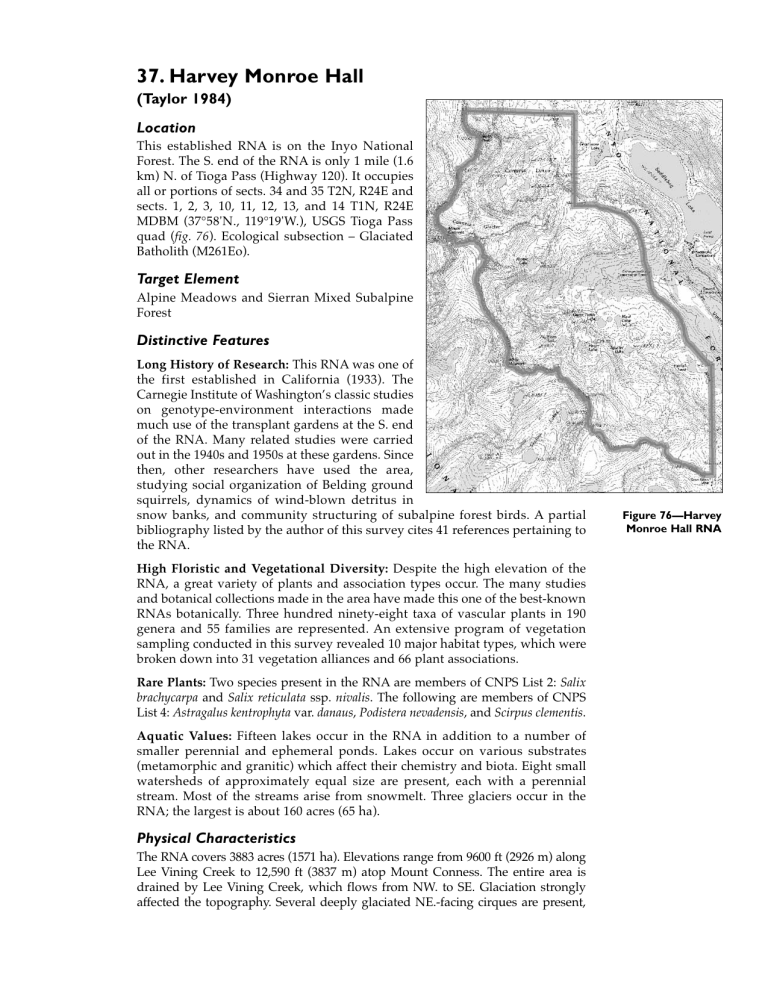37. Harvey Monroe Hall (Taylor 1984) Location

37. Harvey Monroe Hall
(Taylor 1984)
Location
This established RNA is on the Inyo National
Forest. The S. end of the RNA is only 1 mile (1.6
km) N. of Tioga Pass (Highway 120). It occupies all or portions of sects. 34 and 35 T2N, R24E and sects. 1, 2, 3, 10, 11, 12, 13, and 14 T1N, R24E
MDBM (37°58'N., 119°19'W.), USGS Tioga Pass quad ( fig. 76 ). Ecological subsection – Glaciated
Batholith (M261Eo).
Target Element
Alpine Meadows and Sierran Mixed Subalpine
Forest
Distinctive Features
Long History of Research: This RNA was one of the first established in California (1933). The
Carnegie Institute of Washington’s classic studies on genotype-environment interactions made much use of the transplant gardens at the S. end of the RNA. Many related studies were carried out in the 1940s and 1950s at these gardens. Since then, other researchers have used the area, studying social organization of Belding ground squirrels, dynamics of wind-blown detritus in snow banks, and community structuring of subalpine forest birds. A partial bibliography listed by the author of this survey cites 41 references pertaining to the RNA.
High Floristic and Vegetational Diversity: Despite the high elevation of the
RNA, a great variety of plants and association types occur. The many studies and botanical collections made in the area have made this one of the best-known
RNAs botanically. Three hundred ninety-eight taxa of vascular plants in 190 genera and 55 families are represented. An extensive program of vegetation sampling conducted in this survey revealed 10 major habitat types, which were broken down into 31 vegetation alliances and 66 plant associations.
Rare Plants: Two species present in the RNA are members of CNPS List 2: Salix brachycarpa and Salix reticulata ssp. nivalis . The following are members of CNPS
List 4: Astragalus kentrophyta var. danaus , Podistera nevadensis , and Scirpus clementis .
Aquatic Values: Fifteen lakes occur in the RNA in addition to a number of smaller perennial and ephemeral ponds. Lakes occur on various substrates
(metamorphic and granitic) which affect their chemistry and biota. Eight small watersheds of approximately equal size are present, each with a perennial stream. Most of the streams arise from snowmelt. Three glaciers occur in the
RNA; the largest is about 160 acres (65 ha).
Physical Characteristics
The RNA covers 3883 acres (1571 ha). Elevations range from 9600 ft (2926 m) along
Lee Vining Creek to 12,590 ft (3837 m) atop Mount Conness. The entire area is drained by Lee Vining Creek, which flows from NW. to SE. Glaciation strongly affected the topography. Several deeply glaciated NE.-facing cirques are present,
Figure 76—Harvey
Monroe Hall RNA
Figure 77—Harvey
Monroe Hall, View of typical subalpine landscape representative of the H.M. Hall RNA with
Pinus contorta in the foreground. (1982) with steep headwalls and flats or lakes at their floors. Much of the lower elevation area is stepped topography resulting from differential erosion along jointing planes in the granitic bedrock. The granitic rocks are part of the Cathedral Peak Quartz
Monzonite and the Half Dome Quartz Monzonite. They occupy the W. part of the area. The E. portion is underlain by various metamorphic rocks including Paleozoic and Mesozoic metasediments, metadacite, banded calc-silicate hornfels, calc-silicate hornfels varying to limestone-marble, and basic metavolcanics. Soils are typically shallow and poorly developed except in meadows. The climate is high Sierran montane with copious winter snowfall. Average annual precipitation is estimated to be more than 25 inches
(635 mm). There is great variation in temperature and growing season, between S.- and N.-facing slopes, valley bottoms, and so forth.
Association Types
A total of 374 stands of vegetation were sampled
(releve method), and the results classified using the computer-generated TWINSPAN hierarchical system and detrended correspondence analysis ordination to produce the association tables. The primary division is between dry and wet sites. Within dry sites the next division is made between alpine and subalpine communities (a reflection primarily of temperature differences). The next level of division within dry sites is related to late and early snow-melt patterns. Wet site classification is based on site productivity with graminoid-dominated meadows being 2-3 times less productive than tall, herb-dominated associations. A total of 66 vegetation associations, grouping into thirty-one alliances, were delineated. The following summary lists the ten major habitat types with their corresponding alliances and associations. Sizes for associations are not given.
1. Rock Fissures (91200):
Cystopteris fragilis alliance
Heuchera rubescens Cystopteris fragilis association
Oxyria digyna alliance
Draba lemmonii Oxyria digyna association
2. Scree, Talus and Rock Outcrop Communities (91200):
Carex congdonii Arnica amplexicaulis alliance
Arnica amplexicaulis Carex congdonii association
Sambucus microbotrys Carex congdonii association
Artemisia rothrockii alliance
Holodiscus dumosus ( H. microphyllus )Mimulus suksdorfii association
Stipa occidentalis Eriogonum nudum association
Artemisia rothrockii Monardella odoratissima association
Saxifraga nidifica Mimulus rubellus alliance
Saxifraga nidifica Mimulus rubellus association
Rhodiola integrifolia Selaginella watsonii association
Saxifraga bryophora association
Polygonum minimum association
Penstemon newberryi Streptanthus tortuosus alliance
Sedum obtusatum Muhlenbergia montana association
Spiraea densiflora association
Pentaphylloides floribunda ( Potentilla fruticosa ) alliance
Pentaphylloides floribunda Danthonia unispicata association
3. Xeric Alpine Communities (91120):
Minuartia nuttallii ( Arenaria nuttallii )Haplopappus macronema alliance
Minuartia nuttallii association
Calamagrostis purpurascens alliance
Calamagrostis purpurascens Leptodactylon pungens association
Chrysothamnus monocephalus Leptodactylon pungens association
Elymus ( Sitanion ) hystrix-Phlox covillei alliance
Festuca minutiflora Penstemon davidsonii association
Podistera nevadensis Erigeron pygmeaus association
Astragalus kentrophyta Draba oligosperma association
Elymus hystrix Phlox covillei alliance
Phlox covillei Eriogonum incanum association
Ivesia muirii association
Hulsea algida alliance
Macronema discoideum ( Haplopappus macronema )Phacelia frigida association
4. Subalpine Forests (86100, 86210, 86220, 86600):
Pinus contorta (lodgepole pine) alliance ( fig. 77 )
Pinus contorta Carex rossii association
Pinus contorta Thalictrum fendleri association
Pinus contorta Ledum glandulosum association
Pinus albicaulis (whitebark pine) alliance
Pinus albicaulis Poa nervosa association
Pinus albicaulis Penstemon davidsonii association
Tsuga mertensiana (mountain hemlock) alliance
Tsuga mertensiana Arnica cordifolia association
5. Snowpatch Communities (91300):
Juncus parryi alliance
Juncus parryi Eriogonum incanum association
Phyllodoce breweri association
Carex spectabilis Sibbaldia procumbens association
Carex helleri alliance
Eriogonum incanum Raillardella argentea association
Carex helleri Ivesia lycopodioides association
Saxifraga tolmiei Luzula divaricata association
Carex breweri alliance
Carex breweri association
6. Well-Drained Meadows (45220, 45210):
Carex exserta alliance
Carex exserta Saxifraga aprica association
Calamagrostis breweri alliance
Calamagrostis breweri Vaccinium caespitosum association
Calamagrostis breweri Kalmia microphylla association
Salix orestera Calamagrostis breweri association
Juncus drummondii Calamagrostis breweri association
Danthonia unispicata alliance
Piltagrostis ( Oryzopis ) kingii-Senecio scorzonella association
Phleum alpinum Danthonia unispicata association
Melica bulbosa alliance
Stipa lemmonii Carex straminiformis association
Juncus balticus association
7. Tall-Herb and Willow Thickets (63500, 45210):
Salix orestera Allium validum alliance
Salix orestera Allium validum association
Salix orestera Senecio triangularis association
Salix planifolia Carex scopulorum association
Veratrum californicum alliance
Veratrum californicum Senecio triangularis association
Senecio triangularis Carex spectabilis association
Arnica mollis alliance
Arnica mollis Arabis davidsonii association
8. Poorly-Drained Meadows (45210):
Carex luzulaefolia alliance
Carex luzulaefolia Ranunculus alismaefolius association
Carex scopulorum Pedicularis groenlandica alliance
Eriophorum crinigerum Carex scopulorum association
Carex scopulorum Pedicularis groenlandica association
Eleocharis paucifora association
Carex deweyana alliance
Rorippa curvisiliqua Carex deweyana association
Juncus mertensianus association
Carex nigricans alliance
Salix arctica association
Carex subnigricans Dodecatheon alpinum association
Carex nigricans Kalmia microphylla association
Carex vernacula Antennaria alpina association
9. Flowing Springs and Shallow Streams (45210, 63500):
Mimulus tilingii alliance
Claytonia nevadensis association
Mimulus tiningii Poa gracillima association
Deschampsia caespitosa alliance
Deschampsia caespitosa Solidago multiradiata association
10. Shallow Ponds and Standing Water (52430):
Carex rostrata alliance
Torreyochloa ( Puccinellia ) pauciflora-Isoetes bolanderi association
Carex rostrata association
Plant Diversity
Three hundred ninety-eight taxa of vascular plants are listed.
Conflicting Impacts
The area is bounded on the SE. by a good gravel road to Saddlebag Lake and is only a few miles by road from Tioga Pass (Yosemite National Park E. entrance).
However, recreational use of the area is apparently not a significant impact in most areas. In the late 1800s and early 1900s sheep apparently overgrazed much of this area. However, no certain evidence of this impact remains.






